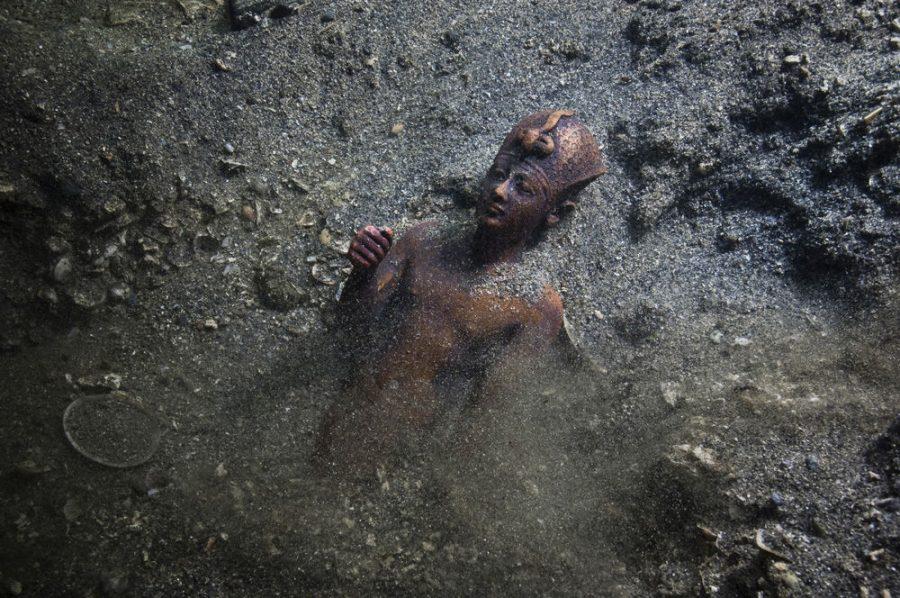Egyptian, Greek styles swirl in ‘Sunken Cities’ artifacts
Published April 19, 2018
If you’ve been thinking about seeing “Sunken Cities: Egypt’s Lost Worlds” at the St. Louis Art Museum, do not wait. That’s because in all likelihood, you’re going to want to go back multiple times to take in all that this special exhibition has to offer.
The first thing that strikes you is the story of the disappearance, discovery and excavation of Thonis-Heracleion, the primary port of entry into Egypt prior to the founding of Alexandria in 331 BCE, and the nearby city of Canopus. Both of these cities in their day were famous for their temples and reputation as holy places.
It is nothing short of remarkable that these two cities, mentioned by classical authors, were swallowed by the Mediterranean Sea and only recently, under the direction of maritime archaeologist Franck Goddio and the European Institute for Underwater Archaeology, have begun to be explored and their treasures, of which there are still many waiting to be excavated, brought to light.
Even if you don’t care too much about the history involved, you see the exhibition anyway, if only to experience the sheer beauty of many of the artifacts on display.
Nothing can really prepare you for the sight of three towering statues, 16 or more feet in height, that once graced a temple in Thonis-Heracleion. Even after centuries of submersion, they remain majestic in size and stature.
Infinitely smaller in scale and intricate in detail but equally breathtaking are delicate, gold jewelry items that were brought by worshippers as offerings to the temples in these pilgrimage cities.
Osiris, Egyptian lord of the afterlife, was central figure in the Egyptian religion and the focus of rituals in Canopus and Thonis-Heracleion that celebrated his mythological murder and resurrection. A number of striking classical representations of Osiris as king of the Upper Kingdom and the Lower Kingdom are included in the exhibit. Especially beautiful is a representation of the awakening of Osiris, its prostrate rising figure with delicate features and an elaborate headdress still alluring after all these centuries.
Surrounded by imposing busts, figures and stele, it is easy to overlook some of the smaller objects on display. Be sure to look for a very beautifully carved limestone head of a ram from the sixth century BCE. This engraving reveals delicacy and detail so exquisite, I found myself drawn back repeatedly in an effort to more fully appreciate it.
Near the entrance to the exhibit is a bust of Neilos, the Greek god of the Nile. While typically Greek in style, the bust is an example of how ancient Greeks living in Egypt incorporated the Nile River, which was venerated by the Egyptians, into their religious pantheon.
The interchange and appropriation of beliefs and artistic styles between Egypt and Greece are also reflected in other works on display, most strikingly in the pose and dress of a statue of Arsinoe and the Black Stone Queen.
By the time you reach the marble sculptures from the temple at Ras El-Soda in Alexandria at the end of the exhibition, the boundaries of what is Egyptian or Greek style are gloriously blurred and blended.
Thinking about the interplay of cultures on each other, I could not help but notice the many religious bronze artifacts on display. These include ewers and hand basins for ritual ablutions by priests, and burners, shovels and spoons for incense offerings. While according to our Jewish tradition similar items created for use in our sanctuary and temple derive from divine authority, their usage as a way to express religious servitude would appear to not necessarily be exclusive to the Jewish tradition.
Before you leave the exhibition, be sure not to miss the extraordinary jeweled, pendantlike pectoral, or breastplate. Look closely at the protective, winged deities on either side of the sun. Perhaps, like me, your mind might turn to images of the winged cherubim that adorned the Ark in the Holy of Holies in our Temple in Jerusalem.
It is not every day that an exhibition of this stature comes to St. Louis after being shown in a number of European venues, so savor it and all that it has to offer.
Stephen Cohen is vice president of special projects at Jewish Federation of St. Louis, but his avocation and passion is art.
















